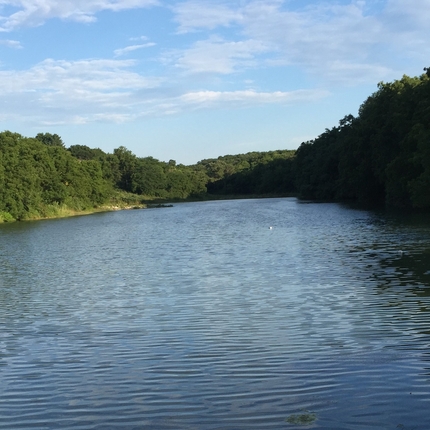In Iowa and other Midwest states, agricultural excellence, robust soils, and ample outdoor recreation are points of pride. All of these elements relate to water, and depend upon healthy watersheds.
For more than a decade, local leaders in Iowa have worked to address water quality and flooding concerns by forming Watershed Management Authorities (WMA). WMAs are collaborative entities that work to implement practices on a local watershed scale. Their activities are concurrent with other state efforts—notably those of the Iowa Department of Natural Resources (DNR) and Iowa Department of Agriculture and Land Stewardship. Each entity, initiative and project plays its part to address Iowa’s water goals.
While the work of the WMAs has led to the implementation of more than 2,600 conservation practices since 2010, more progress is needed. Due to inconsistent funding, Iowa’s 27 WMAs have faced unnecessary hurdles.
“We have had a lot of success in Iowa, and plenty of work lies ahead,” said Kelsey Willardson, policy associate for the Center for Rural Affairs. “Looking to our neighboring states can help provide ideas and inspiration.”
A new Center report “Following the Flow: Upper Mississippi Approaches to Watershed Management” highlights strategies and approaches to watershed management in Wisconsin and Minnesota. Like Iowa, a significant portion of each state falls within the Upper Mississippi River Basin.
“This report does not capture every concurrent effort relating to water, but rather highlights strategies that may present learning opportunities,” said Kelsey, who authored the report.
Wisconsin waters
In Wisconsin, water and wetlands are protected by the state DNR. To encourage cooperation between DNR staff, local governments, and private partners, the state is divided into 24 water management units.
The state takes several approaches to address water quality, including recognizing the impact of agricultural practices and implementing related programming, such as Producer-Led Watershed Protection Grants. Agricultural producers participating in local watershed efforts can receive funding through cost-share programs for conservation projects and research. In 2023, $1 million in grants were awarded to 43 farmer-led groups.
Additionally, Wisconsin started the Healthy Watersheds, High-Quality initiative in 2021. The program is committed to the long-term protection and restoration of waterways, providing funding for maintenance even after watersheds are no longer considered high-risk.
Funding for Wisconsin’s watershed programs comes from competitive grants from the DNR and private organizations. Most commonly, funds and loans are provided by way of EPA Section 319 grants and the State Revolving Fund, which are also a part of Iowa’s strategy to address water concerns.
“Wisconsin has taken unique approaches to address its individual water-quality needs,” Kelsey said. “This has helped the state create and maintain healthy waters for its residents, visitors, and environment.”
Minnesota management
Minnesota has a longer-than-average history of addressing water quality, with legislation established as early as 1955. Today, the state has 42 watershed districts run by citizen advisory committees. In structure, the entities share much in common with Iowa’s WMAs.
Funding for watershed projects is coordinated through the Minnesota Pollution Control Agency. With access to state and federal dollars, the state is able to support new and continuing projects with both competitive and noncompetitive funding options.
Minnesota watershed districts have access to noncompetitive funding through the Clean Water Fund. The fund was established in 2008 when Minnesota voters passed the Clean Water, Land, and Legacy Amendment. The measure increased the state sales and use tax rate starting in 2009 and running until 2034. The added sales tax is less than half a percent and provides funds to protect, monitor, and restore Minnesota’s waterways.
“Watershed districts do not have to worry about losing base funding from year to year, thanks to this program,” Kelsey said.
How these funds are distributed has changed as the program has grown. In 2017, the Minnesota Board of Water and Soil Resources began a pilot program called One Watershed, One Plan to distribute its noncompetitive Clean Water Funds to districts with comprehensive plans that address priority concerns on a long-term basis, rather than the traditional project-to-project approach.
“This ensures sustainable funding so organizers can focus on improving their watersheds rather than securing short-term funding every year, which is a perennial challenge for Iowa’s WMAs,” Kelsey said.
In 2022, more than 3,600 grants to protect and restore water resources were distributed and 66 Minnesota lakes and streams were removed from the impaired waters list.
“Minnesota’s approach to watershed management has been effective,” Kelsey said. “The state’s rigorous approach to water quality and dedication to providing equitable and sustainable funding has enabled these successes.”
Lessons learned
“In Following the Flow,” Willardson highlights these approaches and more as references for future success in Iowa. Minnesota’s Clean Water, Land, and Legacy Amendment is particularly notable for the WMAs.
“Iowa voters have already laid the groundwork for a similar approach,” Willardson said. “In 2010, 63% of voters passed a constitutional amendment to create the Natural Resources and Outdoor Recreation Trust Fund, also known as IWILL. The trust could work similarly to Minnesota’s by providing steady conservation funding, but so far has gone unfunded. Lawmakers should keep their word to Iowa voters, and enact legislation to fund IWILL.”
To read the full report and learn more, click here.





